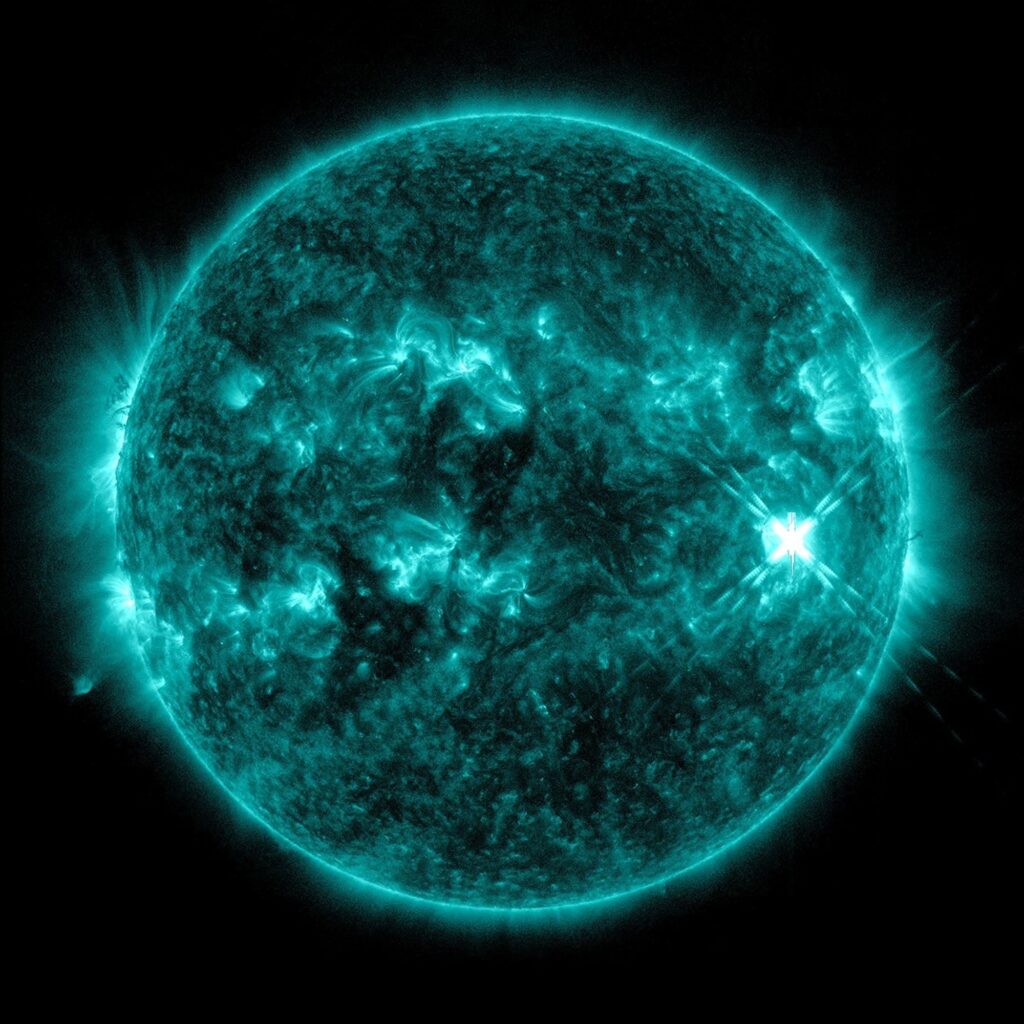
solar flare 2025 activity hit a major milestone. At exactly 5:49 p.m. ET, the Sun erupted with a powerful X1.2-class solar flare, lighting up space and triggering concern across the global scientific community. Captured by NASA’s Solar Dynamics Observatory (SDO), this event marks one of the strongest flares in the current solar cycle—offering both a reminder of solar power and a warning of potential Earth-bound disruptions.
What is a Solar Flare and Why Does It Matter in 2025?
A solar flare is a sudden, explosive burst of electromagnetic energy from the Sun’s surface, often caused by intense magnetic activity. The solar flare 2025 event on June 17 was an X-class flare—the most intense category in the solar flare scale. The numeric suffix “1.2” means it’s stronger than a baseline X1, making it a significant event.
In 2025, we are approaching the peak of Solar Cycle 25, which means the Sun is more active, more volatile, and more likely to produce disruptive flares like this one.
Understanding the X1.2 Classification of the Solar Flare 2025 Event
Solar flares are categorized as:
- C-class: Low impact
- M-class: Moderate potential for minor radio blackouts
- X-class: Extreme—can trigger global radio disruptions, power grid risks, and radiation hazards in space
The June 17 solar flare 2025 was classified as X1.2, placing it in the most dangerous category. While not the most powerful flare ever recorded, it’s a top-tier event in the 2025 solar season.
Solar Flare 2025 Impact: What Can Happen on Earth?
Even when not directly facing Earth, a solar flare like the one on June 17 can cause real-world effects. Here’s what to watch for during high solar activity:
📡 1. Disruption of Radio Signals
High-frequency radio communications can be knocked out for minutes to hours, especially in polar regions. This affects:
- Commercial aviation
- Maritime communications
- Emergency response systems
⚡ 2. Stress on Power Grids
Solar flare energy can induce geomagnetic currents in power lines, potentially overloading transformers and causing regional blackouts. While large utilities plan for these events, a strong solar flare 2025 event could still strain the grid.
🚀 3. Satellite and Spacecraft Anomalies
Radiation from solar flares can interfere with:
- Satellite electronics
- GPS accuracy
- Communications systems
- Spacecraft trajectories
The X1.2 solar flare 2025 event prompted engineers to check on satellite integrity and prepare for possible follow-up coronal mass ejections (CMEs).
🧑🚀 4. Astronaut Safety
The radiation hazard from X-class flares can affect astronauts aboard the ISS or future lunar missions. Though space agencies take precautions, increased solar flare 2025 activity heightens the risk.
How Scientists Monitor Solar Flare 2025 Events
NASA’s Solar Dynamics Observatory (SDO)
NASA’s SDO continuously monitors the Sun in multiple wavelengths, allowing scientists to detect and analyze flare activity in real time. On June 17, it captured dramatic imagery of the solar flare 2025 eruption in ultraviolet light—an essential window into solar physics.
NOAA’s Space Weather Prediction Center (SWPC)
SWPC is the official source for space weather alerts. They issue real-time forecasts, warnings, and alerts related to:
- Radio blackouts
- Solar radiation storms
- Geomagnetic disturbances
To stay updated on future solar flare 2025 events, check spaceweather.gov.
Was There a Coronal Mass Ejection (CME)?
Many X-class flares are associated with CMEs—massive clouds of solar plasma that, when Earth-directed, can trigger geomagnetic storms.
At the time of the June 17 solar flare 2025, scientists were analyzing whether a CME followed the flare. If so, Earth could experience:
- Bright auroras at lower latitudes
- Interference with navigation systems
- Satellite drag in low-Earth orbit
Why the June 17 Solar Flare Matters in 2025
The June 17 event stands out not just for its intensity, but because of its timing. Solar activity in 2025 is expected to peak, meaning more frequent and powerful flares are likely. The solar flare 2025 timeline is now in full swing.
Here’s why this matters:
- More frequent risks to infrastructure
- Greater reliance on space-based systems (satellites, GPS, power grids)
- Opportunities for scientific advancement
The more we study flares like the June 17 X1.2, the better we can model, forecast, and protect against future events.
What You Can Do During Solar Flare 2025 Activity
1. Stay Informed
Check NOAA’s alerts on spaceweather.gov or follow NASA’s social channels for real-time updates.
2. Protect Sensitive Tech
If you work in industries like aviation, marine navigation, or energy, review contingency protocols during high solar activity days.
3. Watch the Skies
Some side effects of solar flare 2025 events are beautiful—like auroras seen far from the poles. Keep an eye out after major flares.
Solar Flare 2025 Timeline and Forecast
Here’s what experts expect for the remainder of 2025:
- Peak activity window: Mid-to-late 2025
- More X-class flares expected: Possibly stronger than X1.2
- Increased CME frequency
- Auroras more frequent across the Northern Hemisphere
Final Thoughts: Why We Should Watch Solar Flare 2025 Closely
The solar flare 2025 event on June 17 is a reminder that we live in the blast zone of a dynamic star. As the Sun heats up this year, it’s more important than ever to monitor space weather. From global communications to power infrastructure and astronaut safety, the stakes are high—and rising.
Thanks to NASA and NOAA’s relentless work, we can predict and respond faster than ever before. But awareness is the first line of defense. Keep solar flare 2025 on your radar—because the Sun is just getting started.